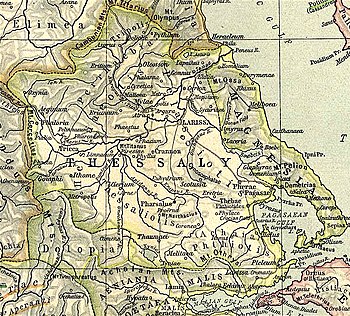39°34′12″N 22°11′30″E / 39.57005°N 22.19173°E

Atrax (Ancient Greek: Ἄτραξ, or Ἄτραγος[1] or Ἄτρακοϛ[2]) or Atracia (Ἀτρακία)[3][4] was a Perrhaebian town in ancient Thessaly, described by Livy as situated above the river Peneius, at the distance of about 10 miles (16 km) from Larissa.[5] Strabo says that the Peneius passed by the cities of Tricca, Pelinnaeum and Pharcadon, on its left, on its course to Atrax and Larissa.[6] The town is attested as Ἆδρακος in the nominative in a catalog of theorodokoi of Epidaurus,[7] dating from 363-359 BCE.[8] It was also a polis (city-state) in antiquity.[9]
- ^ Supplementum Epigraphicum Graecum 34.560.3 c. 450 BCE)
- ^ Strabo. Geographica. Vol. 9.5.20. Page numbers refer to those of Isaac Casaubon's edition.
- ^ Stephanus of Byzantium. Ethnica. Vol. s.v.
- ^ Ptolemy. The Geography. Vol. 3.13.42.
- ^ Livy. Ab urbe condita Libri [History of Rome]. Vol. 32.15, 36.13.
- ^ Strabo. Geographica. Vol. ix. p.438. Page numbers refer to those of Isaac Casaubon's edition.
- ^ IG iv2.1 94.b.3.
- ^ Perlman, P. (2000). City and Sanctuary in Ancient Greece. The Theorodokia in the Peloponnese, Hypomnemata 121. Göttingen, p. 178 E.1b3
- ^ Mogens Herman Hansen & Thomas Heine Nielsen (2004). "Thessaly and Adjacent Regions". An inventory of archaic and classical poleis. New York: Oxford University Press. p. 692. ISBN 0-19-814099-1.